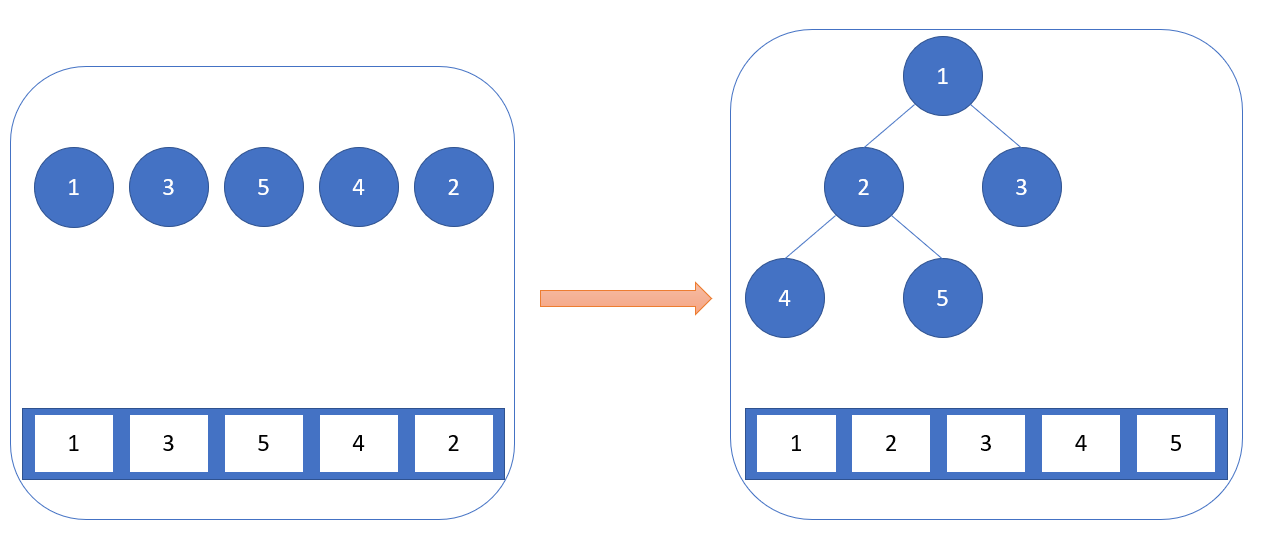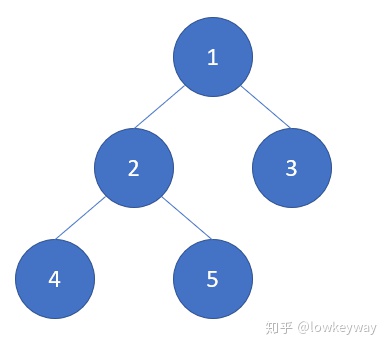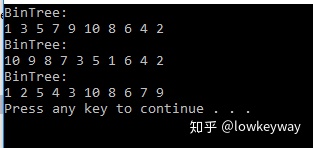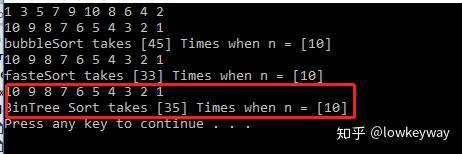
源于生活,抽象生活。
欠下的债总是要还的,我们讨论堆排序,用到的就是二叉堆,聊起二叉堆,我们又要反过来倒回到之间介绍的二叉树系列。
生活中的堆排序
一提二叉树,我总是想起来挂在老家的家谱,可惜不能拍照。

这就是严格的等级排序,最上面的就是辈分最大的,最下面的,就是辈分最小的。
计算机中的堆排序
貌似我们有好多东西要讲。千里之行,始于足下。一个个来吧。
什么是堆排序?
就是利用二叉堆的特性进行排序的方式。
那什么又是二叉堆?它有什么特性?
二叉堆本质上就是一种完全二叉树,它分为两种:
- 最大堆:任何一个父节点的值,都大于或等于它左、右孩子节点的值。
- 最小堆:任何一个父节点的值,都小于或等于它左、右孩子节点的值。
可以想象:最大堆的堆顶是整个堆的最大元素,最小堆的堆顶是整个堆的最小元素。
什么是完全二叉树?
那我建议还是先返回去看看二叉树的实现那一节。
只有最后两层的节点的度能小于2,并且最后1层的叶子节点必须靠左边。这样的树就叫完全二叉树。
它有个特点:将整个完全二叉树依照从左到右,从上到下的进行0-->n进行编号,若子节点序号为i,则父节点为(i-1)/2。
文字好无力,还是公式和图好:

我们先用代码来实现以下完全二叉树。
老规矩,还是要先写大纲,再下笔:
- 我们要写一个二叉堆,它是一个完全二叉树。
- 跟之前写的二叉树有些不同的是,这个二叉树不是链表构成的,而是数组下标查询的。因为是完全二叉树,那么如果父节点的下标是parent,左孩子的小标就是2parent+1,右孩子下标就是2*parent+2.
- 它应该带有自我构建的功能,就是说对于一个无需的数组,它应该可以自己把最大/最小值上浮,最后达到最大堆/最小堆的特征需求。
注意点:
1. 在下沉元素时,必须要从下到上一次轮询;
2. 轮询过程中,一定要下沉到不能下沉为止。
BinTree.h
#ifndef __BIN_TREE_H__
#define __BIN_TREE_H__
#include <string>
#include <iostream>
#ifndef SWAP(X, Y)
#define SWAP(X, Y) (X)=(X)+(Y);(Y)=(X)-(Y);(X)=(X)-(Y)
#endif // !SWAP(X, Y)
using namespace std;
typedef enum BigLittle
{
BIG = 0,
LITTLE = 1
}BIG_LITTLE;
class BinTree
{
public:
BinTree(int* p, int cap);
~BinTree();
bool buildHeap(BIG_LITTLE bl);
bool showBinTree();
public:
int* m_piBinTree;
int m_iCap;
int m_iCount;
};
#endif // !__BIN_TREE_H__
BinTree.cpp
#include "binTree.h"
BinTree::BinTree(int* p, int cap)
{
if (cap <= 0)
{
cout << "Please input correct number!" << endl;
return;
}
m_piBinTree = new int[cap];
if (NULL == m_piBinTree)
{
cout << "BinTree NEW fail!" << endl;
return;
}
memset(m_piBinTree, 0, sizeof(int)*cap);
memcpy(m_piBinTree, p, sizeof(int)*cap);
m_iCap = cap;
m_iCount = 0;
}
BinTree::~BinTree()
{
delete[]m_piBinTree;
}
bool BinTree::showBinTree()
{
if (m_iCap <= 0)
{
cout << "Please init BinTree frist!" << endl;
return false;
}
cout << "BinTree: " << endl;
for (int i = 0; i < m_iCap; i++)
{
cout << m_piBinTree[i] << " ";
}
cout << endl;
return true;
}
bool BinTree::buildHeap(BIG_LITTLE bl)
{
int childIndex, parentIndex;
if (m_iCap <= 0)
{
cout << "Please init BinTree frist!" << endl;
return false;
}
m_iCount = 0;
for (int i = (m_iCap - 2) / 2; i >= 0; i--)
{
if (BIG == bl)
{
parentIndex = i;
childIndex = 2 * parentIndex + 1;
while (childIndex < m_iCap)
{
if (childIndex + 1 < m_iCap && m_piBinTree[childIndex] < m_piBinTree[childIndex + 1])
{
childIndex++;
}
if (m_piBinTree[parentIndex] < m_piBinTree[childIndex])
{
SWAP(m_piBinTree[parentIndex], m_piBinTree[childIndex]);
}
parentIndex = childIndex;
childIndex = 2 * childIndex + 1;
m_iCount++;
}
}
else if (LITTLE == bl)
{
parentIndex = i;
childIndex = 2 * parentIndex + 1;
while (childIndex < m_iCap)
{
if (childIndex + 1 < m_iCap && m_piBinTree[childIndex] > m_piBinTree[childIndex + 1])
{
childIndex++;
}
if (m_piBinTree[parentIndex] > m_piBinTree[childIndex])
{
SWAP(m_piBinTree[parentIndex], m_piBinTree[childIndex]);
}
parentIndex = childIndex;
childIndex = 2 * childIndex + 1;
m_iCount++;
}
}
else
{
cout << "SomeThing Wrong!" << endl;
return false;
}
}
return true;
}测试程序
#include "MySort.h"
#include "binTree.h"
#define LEN(X) (sizeof(X)/sizeof(X[0]))
using namespace std;
int myArray[] = { 1, 3, 5, 7, 9, 10, 8, 6, 4, 2 };
int main()
{
//MySort M(myArray, LEN(myArray));
//M.bubbleSort(DOWN);
//M.fasteSort(DOWN);
BinTree B(myArray, LEN(myArray));
B.showBinTree();
B.buildHeap(BIG);
B.showBinTree();
B.buildHeap(LITTLE);
B.showBinTree();
system("pause");
return true;
}
好了,我们实现了二叉堆,那么我们怎么利用二叉堆来实现二叉堆排序呢?
很简单,以最大堆为例:
- 我们知道,cap(cap要大于等于1)大小的数组二叉堆排序后堆顶肯定是这个堆的最大值;
- 我们可以把堆顶的元素跟堆尾的元素交换;
- 以cap-1这么大的数组再做一次二叉堆排序,循环到1;
- 直到cap减小到0,那么这个时候数组存储的二叉堆就变成了一个升序排列;
有了方法,用代码来实现:
注意事项:
1. 貌似没什么可注意的,思路清晰了,代码简洁没什么难度。
MySort.h
#ifndef __MY_SORT_H__
#define __MY_SORT_H__
#include <iostream>
#include <string>
#include "binTree.h"
typedef enum UpDown
{
UP = 0,
DOWN = 1
}UP_DOWN;
class MySort
{
public:
MySort(int* p, int cap);
~MySort();
bool showArray(int* p, int len);
bool bubbleSort(UP_DOWN Up_Down);
bool fasteSort(UP_DOWN Up_Down);
bool fastSortImp(int *pFast, int iCap);
bool binTreeSort(UP_DOWN Up_Down);
public:
int* m_ipArray;
int m_iCap = 0;
unsigned long m_ulCount;
};
#endif // !__MY_SORT_H__
MySort.cpp
增加binTreeSort接口
bool MySort::binTreeSort(UP_DOWN Up_Down)
{
DWORD count = 0;
BIG_LITTLE bigLittle = Up_Down == UP ? BIG : LITTLE;
if (m_iCap <= 0)
{
cout << "Please input array frist!" << endl;
return false;
}
int* pBinTree = new int[m_iCap];
if (NULL == pBinTree)
{
cout << "New Fail!" << endl;
return false;
}
m_ulCount = 0;
memset(pBinTree, 0, sizeof(pBinTree[0]) * m_iCap);
memcpy(pBinTree, m_ipArray, sizeof(pBinTree[0]) * m_iCap);
BinTree B(pBinTree, m_iCap);
for (int i = m_iCap - 1; i > 1; i--)
{
B.buildHeap(bigLittle);
SWAP(B.m_piBinTree[0], B.m_piBinTree[i]);
B.m_iCap--;
m_ulCount += B.m_iCount;
}
memcpy(pBinTree, B.m_piBinTree, sizeof(pBinTree[0]) * m_iCap);
showArray(pBinTree, m_iCap);
printf("BinTree Sort takes [%lu] Times when n = [%d] n", m_ulCount, m_iCap);
delete[]pBinTree;
return true;
}
测试程序:
#include "MySort.h"
#include "binTree.h"
#define LEN(X) (sizeof(X)/sizeof(X[0]))
using namespace std;
int myArray[] = { 1, 3, 5, 7, 9, 10, 8, 6, 4, 2 };
int main()
{
MySort M(myArray, LEN(myArray));
M.bubbleSort(DOWN);
M.fasteSort(DOWN);
M.binTreeSort(DOWN);
//BinTree B(myArray, LEN(myArray));
//B.showBinTree();
//B.buildHeap(BIG);
//B.showBinTree();
//B.buildHeap(LITTLE);
//B.showBinTree();
system("pause");
return true;
}运行结果:






















 619
619

 被折叠的 条评论
为什么被折叠?
被折叠的 条评论
为什么被折叠?








